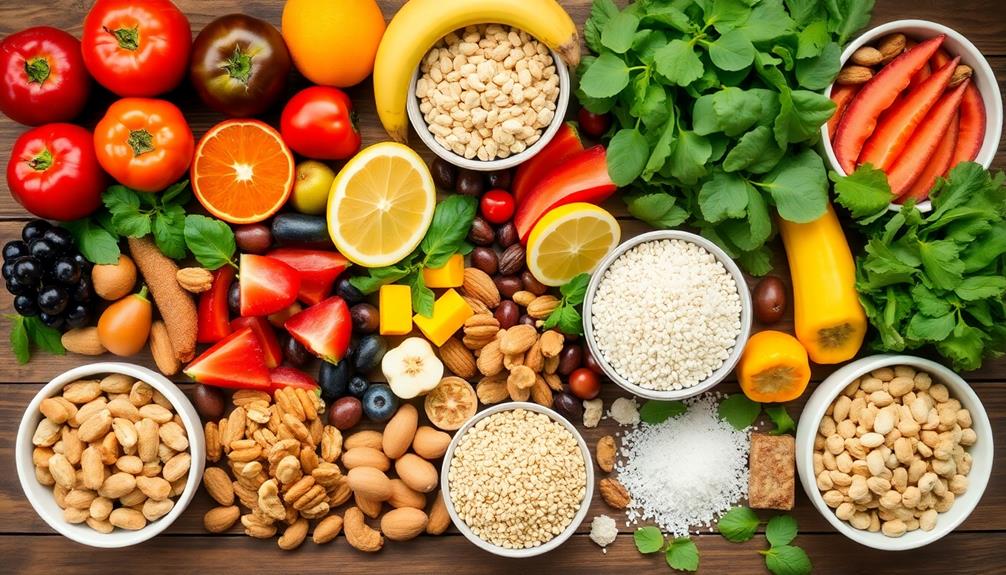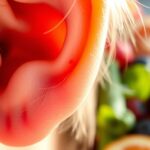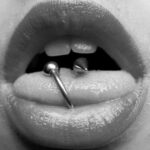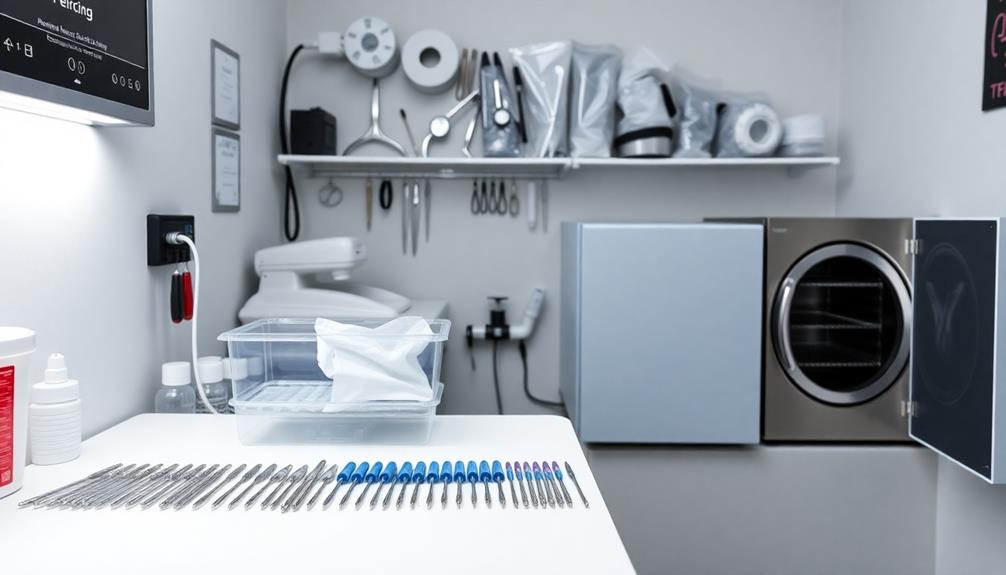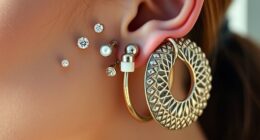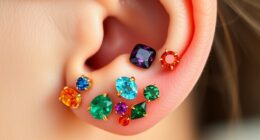Your diet plays an essential role in healing after a piercing. Eating soft, non-irritating foods like yogurt and applesauce can aid your recovery. Stay hydrated with warm soups and avoid spicy or acidic foods, which can irritate the piercing. During healing, gentle proteins like scrambled eggs and well-cooked fish help repair tissues. Keep an eye on how different foods affect you, as some may cause discomfort. Chewing slowly and thoughtfully also minimizes stress on the piercing. By making mindful food choices, you pave the way for a smoother healing journey. There's more you can explore about ideal recovery strategies.
Key Takeaways
- A balanced diet rich in vitamins and minerals supports the immune system and promotes healing after a piercing.
- Soft, cold foods like yogurt and ice cream minimize irritation and soothe swelling during the initial recovery phase.
- Avoid spicy, acidic, and hard foods to prevent discomfort, irritation, and potential damage to the piercing.
- Gradual reintroduction of gentle proteins and soft fruits helps maintain nutrition while minimizing irritation in mid-healing stages.
- Monitoring body reactions to new foods is essential for identifying irritants and ensuring a healthy healing environment.
The Role of Diet in Healing
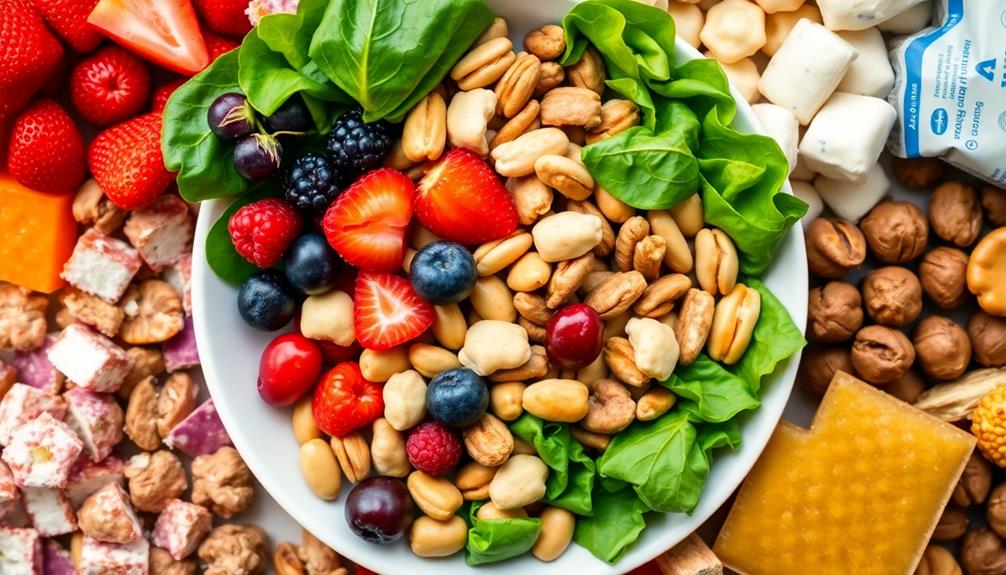
A well-balanced diet plays an essential role in your healing process after a piercing. Good nutrition provides your body with the vitamins and minerals it needs to support your immune system, which is vital for effective healing. Focus on consuming whole, unprocessed foods that help reduce inflammation and offer the necessary nutrients for ideal recovery.
Additionally, certain herbal teas, such as chamomile and hibiscus, can promote relaxation and may support mood stability during your healing journey, which is beneficial for overall well-being and recovery aiding in stress reduction.
During the initial healing phase, opt for soft foods like yogurt and smoothies. These foods are easy to chew and minimize irritation at the piercing site, allowing for a more comfortable healing experience. It's wise to avoid spicy foods and acidic items, as they can cause inflammation and prolong your recovery time.
Hydration is equally important in this process. Drinking plenty of water not only supports your overall health but also aids your body's natural healing processes.
Initial Foods for Recovery
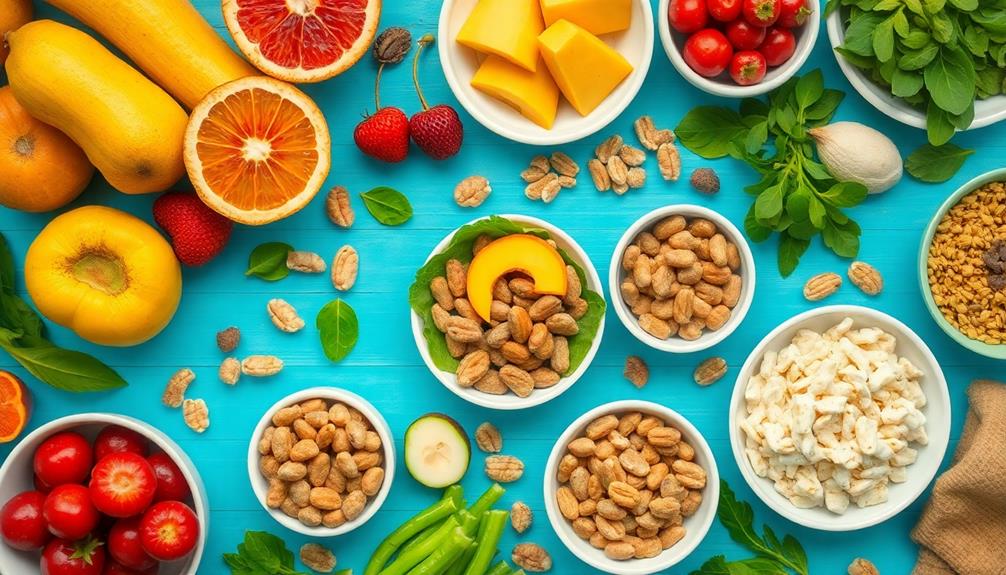
Choosing the right foods during the initial healing phase after a piercing can greatly impact your comfort and recovery. During this time, you'll want to focus on soft foods that won't irritate the tongue or cause discomfort. Yogurt and applesauce are excellent choices, providing nourishment while being gentle on your sensitive areas.
Cold foods like ice cream and popsicles can also be a lifesaver; they soothe swelling and help reduce inflammation. Hydrating broths and lukewarm soups are perfect for maintaining your nutrition while avoiding irritation. These options support the healing process without causing additional pain.
It's essential to steer clear of spicy foods during this initial healing period. Spices can lead to increased pain and inflammation, making your recovery more challenging. Remember, your goal is to minimize discomfort, so keep your meals simple and soothing.
Also, when drinking liquids, avoid using straws. The sucking motion can strain your piercing and may cause injury.
Stick to these food choices, and you'll be setting yourself up for a smoother recovery experience.
Foods to Avoid
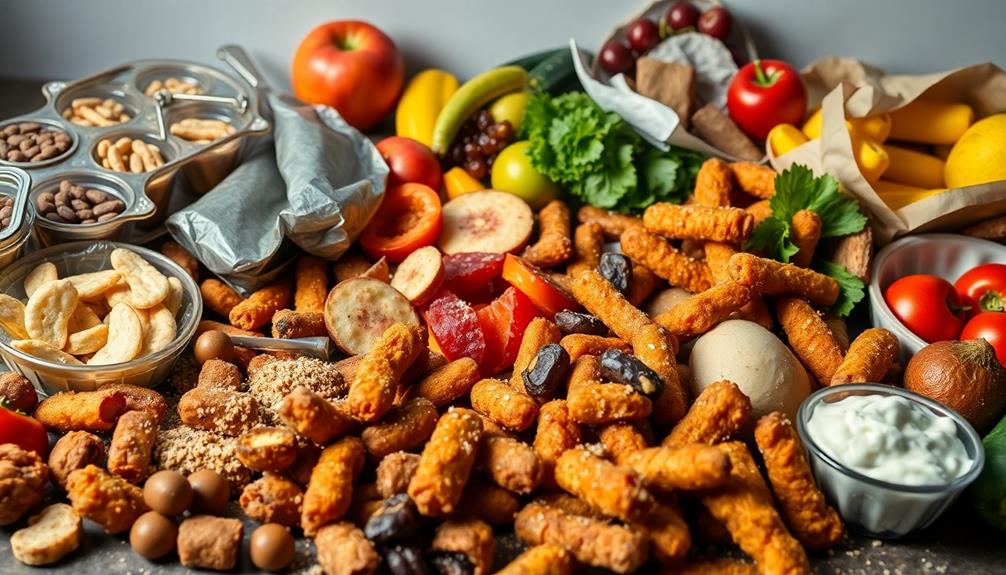
Certain foods can greatly hinder your healing process, so it is crucial to know what to avoid after getting a piercing. Steering clear of certain items will help you recover more smoothly and efficiently.
| Foods to Avoid | Reasons |
|---|---|
| Spicy Foods | Can irritate the piercing, causing discomfort. |
| Acidic Foods | Citrus and vinegar can lead to stinging and delays healing. |
| Hard Foods | Crunchy items like chips may damage the piercing. |
| Dairy Products | May increase mucus and infection risk. |
| Alcohol | Causes swelling, bleeding, and impairs immunity. |
Safe Choices in Mid-Healing
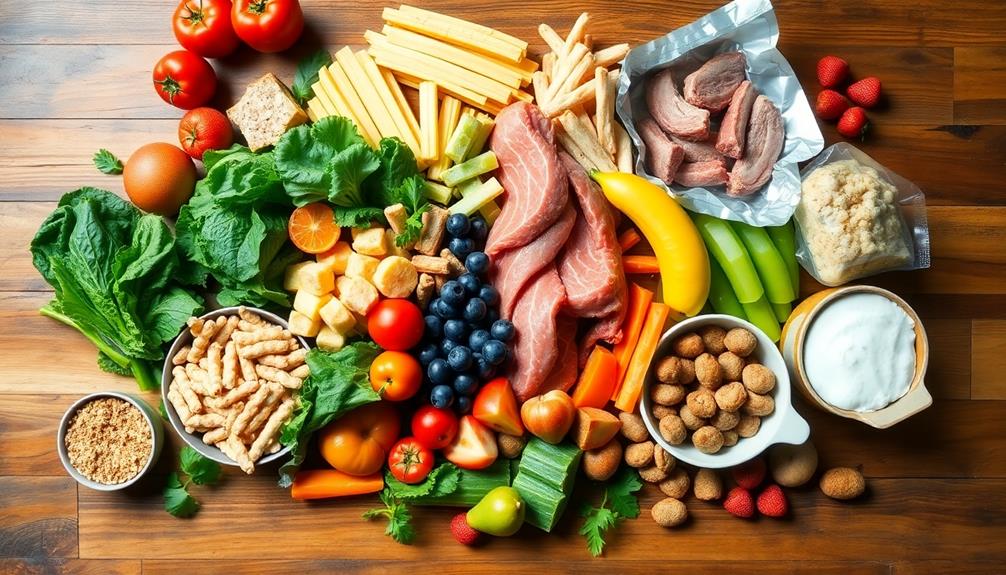
During the mid-healing stage, it's vital to focus on safe food choices that support your recovery. You want to avoid complications and guarantee your healing tongue can handle what you eat. Here are three safe food options to take into account:
- Gentle proteins: Scrambled eggs and fish provide significant nutrients without irritating your piercing.
- Mashed potatoes and pureed vegetables: These are easy to consume and can reduce discomfort during healing.
- Smoothies: Made with soft fruits, they're soothing and help maintain hydration, promoting overall healing.
As you begin to reintroduce solid foods, do it gradually and pay attention to how your body reacts. This approach will help you assess your tolerance and identify any potential issues.
Final Stages of Eating
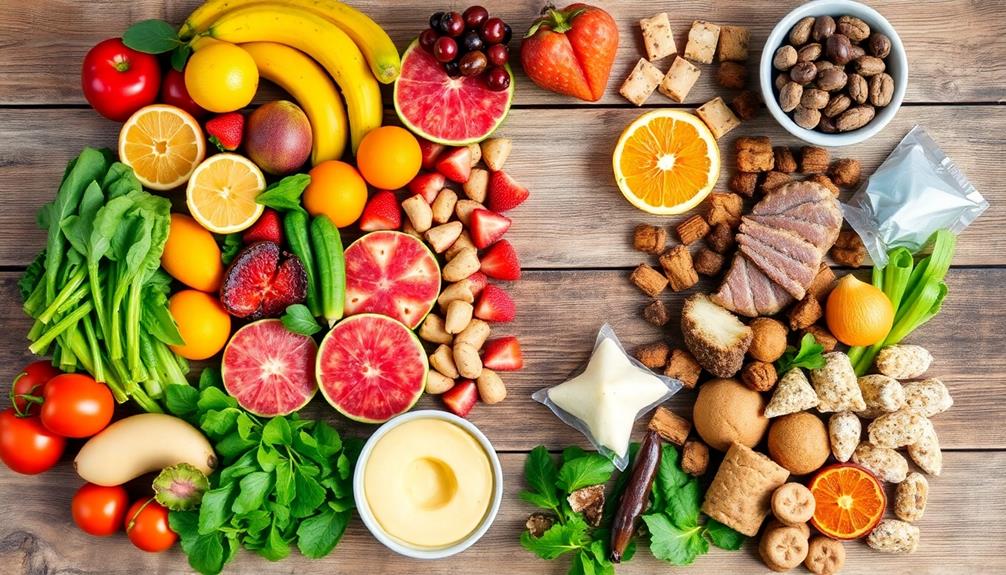
As you reach the final stages of healing, it's time to reintroduce crisp foods like melons and berries, which offer hydration without irritating your piercing.
Pay attention to how your body reacts as you gradually add in tender meats and finely chopped nuts.
Monitoring your dietary tolerance is key to ensuring a smooth recovery while avoiding any discomfort from spicy or acidic foods.
Reintroducing Crisp Foods
In the final stages of healing, you can start to enjoy crisp foods that not only add variety to your diet but also provide invigorating flavors.
Reintroducing crisp foods can be delightful, but you still need to be cautious. Here are some options to contemplate:
- Fruits: Enjoy cool, crisp fruits like melons and berries, which are low in acidity and revitalizing.
- Tender Meats: Include well-cooked chicken or fish, cut into small pieces. This minimizes chewing strain while ensuring you get your protein.
- Nuts and Seeds: Opt for finely chopped nuts and seeds to avoid irritation while reaping their nutritional benefits.
While you explore these new textures, remember to avoid overly spicy or acidic foods that can lead to discomfort, especially with tongue piercings.
Even during this later stage of successful healing, it's crucial to chew slowly to protect the integrity of your piercing.
This way, you'll support continued recovery while enjoying the exciting flavors of crisp foods.
Monitoring Dietary Tolerance
Understanding your body's responses is essential in the final stages of healing. As you reintroduce foods, it's important to monitor how your piercing reacts. Start with gentle options like crisp, cool fruits such as melons and berries. These not only provide hydration and nutrients but are also unlikely to cause irritation.
You can gradually add well-cooked, tender meats cut into small pieces to guarantee you get enough protein without disturbing the healing process.
However, continue to avoid spicy and acidic foods. Even at this stage, these items can lead to discomfort and impede your healing efforts. Pay close attention to any signs of irritation or discomfort when trying new foods. This self-monitoring will help you recognize which foods might be problematic.
If you notice any adverse reactions, it's best to revert to safer options and give your body more time to heal. Remember, everyone's tolerance is different, so be patient with yourself as you shift back to a normal diet.
Eating Techniques for Comfort
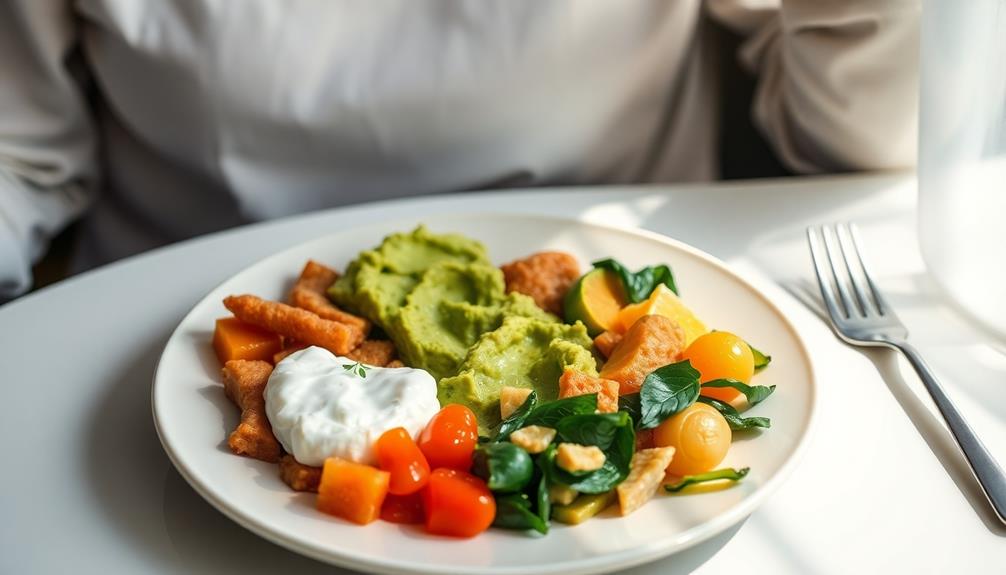
When it comes to eating techniques for comfort during the healing of your piercing, taking your time is key. Rushing through meals can lead to discomfort and potential injury, so focus on a few strategies to make eating more pleasant.
- Chew Slowly: Take your time with each bite. Chewing slowly not only minimizes irritation but also allows you to be more aware of the food's position in your mouth, keeping it away from the piercing.
- Cut Food into Small Pieces: Make meals easier by cutting food into small pieces. This reduces strain on your tongue and makes chewing simpler, which is essential during the healing phase.
- Avoid Using Straws: Straws might seem convenient, but the sucking motion can irritate your piercing. Stick to drinking straight from a glass to keep things comfortable.
Lastly, maintain a calm, comfortable eating environment. This encourages slow eating and helps you focus on your food, further protecting your piercing during the healing process.
Long-Term Dietary Adjustments
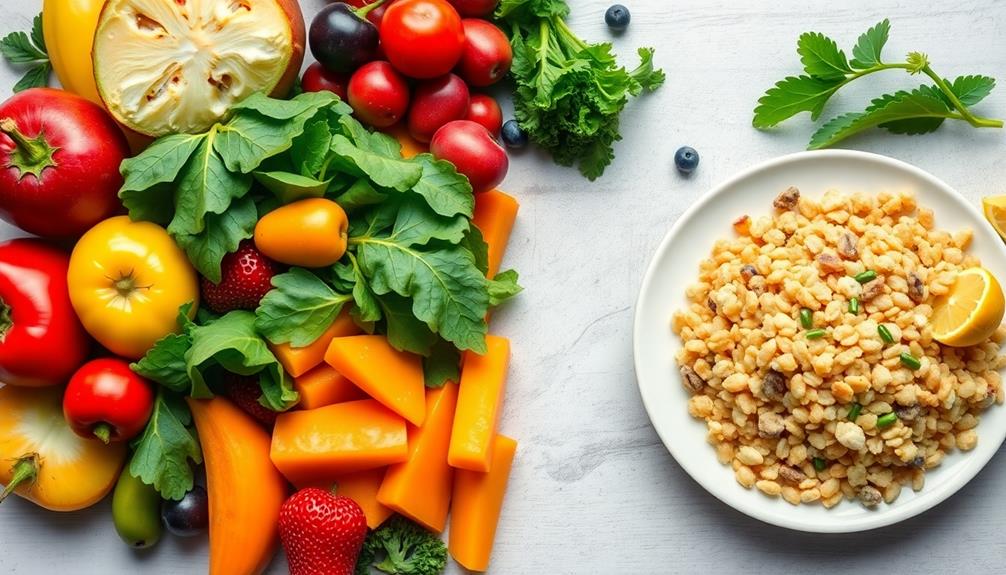
As you move beyond the initial healing phase, it's important to gradually reintroduce a variety of foods while keeping an eye on how your body reacts.
Incorporating healthy fats and proteins can enhance your body's healing process, so consider options like avocados and lean meats.
Maintaining a balanced diet rich in vitamins and minerals not only supports your overall health but also aids in the healing of your piercing.
Make sure to monitor any discomfort when trying new foods, as everyone's tolerance can differ greatly.
For those interested, essential low carb foods can also be beneficial during this period.
Gradual Food Reintroduction
Reintroducing foods after your piercing has healed is an essential step in supporting long-term recovery and comfort.
You'll want to start with soft, non-irritating options to minimize discomfort and allow your body to assess tolerance.
Here are three food categories to evaluate during this gradual reintroduction phase:
- Gentle Proteins: Incorporate scrambled eggs and well-cooked fish to aid in recovery without causing irritation.
- Smoothies: Blend soft fruits into smoothies for added nutrients. They not only provide hydration but also soothe any lingering discomfort.
- Monitor Spicy and Acidic Foods: As you reintroduce these items, keep an eye out for any irritation or adverse reactions.
Nutritional Balance Maintenance
After successfully reintroducing foods, it's important to focus on maintaining a balanced diet to support your long-term healing.
Prioritizing nutritional balance is fundamental for enhancing your immune response, which plays a key role in the healing process of your piercings. Incorporating whole foods rich in vitamins and minerals, like vitamin C and zinc, can promote faster recovery, while also aligning with a high vibrational energy that aids your overall wellness visualization techniques for peak performance.
Lean proteins, such as chicken and fish, are essential for tissue repair and collagen production.
Don't forget to load up on fruits and vegetables, as they're high in antioxidants that help reduce inflammation and protect against oxidative stress. This further aids in your recovery.
It's equally important to limit processed foods and sugars, which can lead to increased inflammation and hinder your overall health, ultimately affecting the healing of your piercings.
Staying hydrated is critical, so drink plenty of water and choose whole foods over refined options. This approach guarantees your body has the necessary nutrients to support peak healing and reduces the risk of complications.
Monitoring Food Reactions
Monitoring your body's reactions to food is essential for guaranteeing a smooth healing process for your piercings. After the initial healing phase, gradually reintroducing a variety of foods allows you to identify any irritants or allergens. Keeping a food diary can greatly aid in this endeavor.
Here are three key steps to reflect on:
- Track Your Intake: Write down everything you eat and note any discomfort or irritation at the piercing site. This will help you pinpoint problematic foods.
- Watch for Signs of Inflammation: Pay close attention to any signs of inflammation or discomfort when trying new foods. These reactions may indicate a need for further dietary restrictions.
- Consult a Healthcare Professional: If you're unsure about your reactions or need personalized advice, don't hesitate to consult a healthcare professional or nutritionist. They can help guide your long-term dietary adjustments.
Ultimately, long-term dietary changes may involve permanently avoiding certain foods, like spicy or acidic items, to maintain a healthy healing environment.
Recognizing Healing Complications
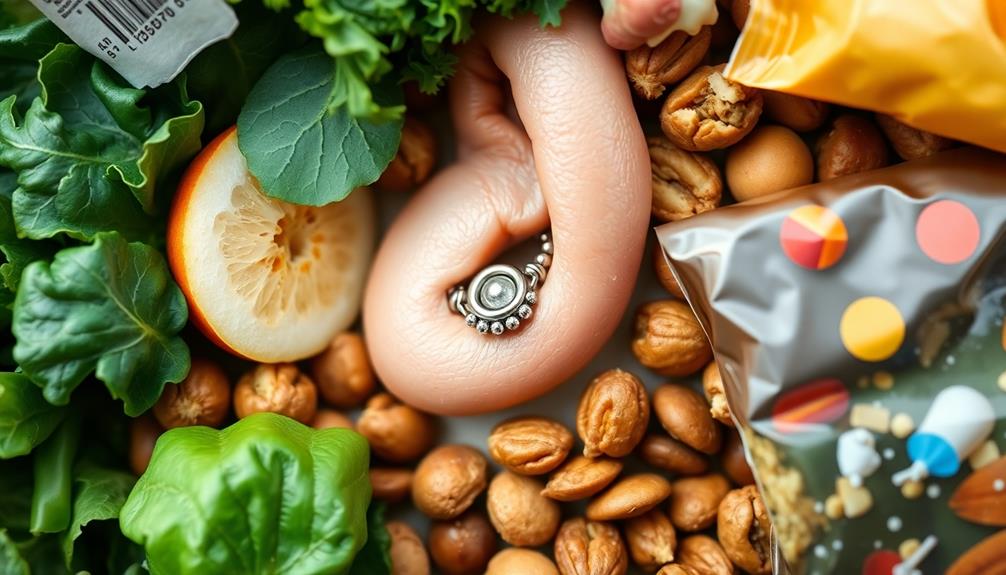
Recognizing complications during the healing process of your piercing is essential for a successful outcome. Pay close attention to signs of infection, like prolonged pain, redness, swelling, and pus. If you notice any of these symptoms, consult a piercing professional or healthcare provider immediately.
Poor oral hygiene can exacerbate these issues, so maintaining cleanliness is imperative. Regular saline rinses can help prevent complications.
Be mindful of your diet, as certain foods can cause irritation. Spicy dishes, for example, can increase inflammation and discomfort, risking the healing process. Additionally, excessive chewing or playing with your piercing can lead to chipped or cracked teeth.
It's essential to adopt careful eating habits to minimize physical stress on the area.
Choosing hypoallergenic jewelry is also important, as allergic reactions can lead to irritation and discomfort, complicating your recovery.
Remember, complications like gum recession can occur in up to 35% of long-term tongue ring users, so keep an eye on your oral health throughout the healing period.
Frequently Asked Questions
What Foods to Avoid After Piercing?
After piercing, you should avoid spicy foods, dairy products, hard snacks, alcohol, and processed items. These can irritate the area, increase infection risk, and hinder your healing process, so stick to gentle, nutritious options instead.
Does Diet Affect Piercing Healing?
You know what they say, "You are what you eat." Your diet definitely affects piercing healing. Proper nutrition helps your body recover faster, while poor choices can slow the process and lead to complications.
What Foods Should You Avoid After Getting Your Tongue Pierced?
After getting your tongue pierced, avoid spicy, acidic, hard, and dairy foods. These can irritate the piercing, cause discomfort, or increase infection risk, ultimately slowing down your healing process. Prioritize soft, bland foods instead.
What Is the Best Thing to Eat After a Piercing?
After getting pierced, think of your mouth as a delicate garden. Nourish it with cool, soft foods like yogurt and smoothies. They'll soothe your healing process while avoiding irritation, letting your garden flourish beautifully.
Conclusion
In the journey of healing your piercing, think of your diet as the compass guiding you through uncharted waters. Nourishing foods are like a lighthouse, illuminating your path to recovery, while unhealthy choices can be the stormy waves that hinder your progress. By steering clear of irritants and embracing wholesome options, you'll not only promote healing but also foster a vibrant connection between your body and spirit. Remember, every bite counts in this delicate dance of recovery.
Hi, my name is Danielle, and I’m an author for piercings-body.com. I have a passion for writing and love to share my knowledge on all things body piercing-related. I’m also a huge advocate for safe body modification practices and believe everyone should be able to make informed decisions about their bodies. When I’m not writing or blogging, I enjoy spending time with my family and friends, practicing yoga, and exploring new places.

